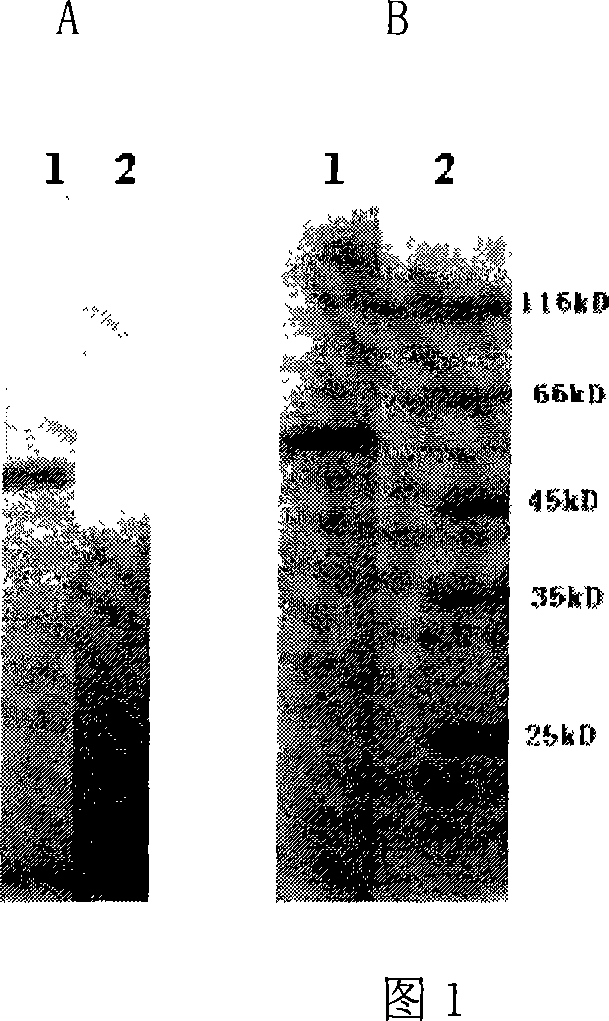Isolation and purification method for high-yield of low-temperature catalase by antarctic marine bacillus n2a
A technology of marine bacillus and catalase, applied in the field of marine microbial enzymes, can solve the problems of unsatisfactory, poor effect, long steps, etc., and achieve the effect of simple process, fast effect, and economical separation and purification
Inactive Publication Date: 2010-08-25
YELLOW SEA FISHERIES RES INST CHINESE ACAD OF FISHERIES SCI
View PDF0 Cites 0 Cited by
- Summary
- Abstract
- Description
- Claims
- Application Information
AI Technical Summary
Problems solved by technology
Yumoto et al. first reported the properties of the low-temperature catalase (VRC) of the facultative psychrophilic bacteria Vibrio rumoiensis, and Lorentzen et al. studied the low-temperature catalase (VSC) from the fish pathogen Vibrio salmonicida, which made people preliminary Knowing low-temperature catalase, there are many differences between these two low-temperature enzymes and common low-temperature enzymes: the activity of VRC is much higher than that of bovine liver catalase and other medium-temperature enzymes at 40°C; the Km of VSC is at low temperature and medium temperature conditions are all lower than the catalase (PMC) of Proteus mirabilis; the separation and purification method to obtain VSC and VRC simultaneously is complicated, the steps are long, and the effect is not good enough, which cannot meet the needs of modern industry
Method used
the structure of the environmentally friendly knitted fabric provided by the present invention; figure 2 Flow chart of the yarn wrapping machine for environmentally friendly knitted fabrics and storage devices; image 3 Is the parameter map of the yarn covering machine
View moreImage
Smart Image Click on the blue labels to locate them in the text.
Smart ImageViewing Examples
Examples
Experimental program
Comparison scheme
Effect test
Embodiment 1
the structure of the environmentally friendly knitted fabric provided by the present invention; figure 2 Flow chart of the yarn wrapping machine for environmentally friendly knitted fabrics and storage devices; image 3 Is the parameter map of the yarn covering machine
Login to View More PUM
| Property | Measurement | Unit |
|---|---|---|
| catalytic efficiency | aaaaa | aaaaa |
Login to View More
Abstract
The invention relates to a separation and purification method of high yield and low-temperature catalase of Antarctic marine Bacillus sp n2a. The invention can achieve electrophoretic pure low-temperature catalase through the processing of strains shaking culture, the ultrasonication ammonium sulfate precipitation, anion-exchange chromatography and gel filtration. With simple processing art, and fast and good effect, the invention can be used for separating and purifying low-temperature catalase in effective, reliable and economical way.
Description
technical field The invention relates to the field of marine microbial enzymes, in particular to a method for separating and purifying high-yield low-temperature catalase from Antarctic marine bacillus n2a. Background technique There are many kinds of low-temperature microorganisms living in the low-temperature environments of high mountains, deep seas and poles on the earth. They have evolved a complete set of adaptation mechanisms for survival and reproduction at around 0°C. Low temperature greatly reduces the rate of chemical reactions. How do low-temperature microorganisms maintain the normal progress of important biochemical reactions? , Enzymes that maintain normal activity at low temperatures are the key to ensuring the normal metabolism of low-temperature microorganisms. Low-temperature enzymes that catalyze important reactions are an important part of the study on the mechanism of low-temperature microorganisms adapting to low temperature. Generally, the activation...
Claims
the structure of the environmentally friendly knitted fabric provided by the present invention; figure 2 Flow chart of the yarn wrapping machine for environmentally friendly knitted fabrics and storage devices; image 3 Is the parameter map of the yarn covering machine
Login to View More Application Information
Patent Timeline
 Login to View More
Login to View More Patent Type & Authority Patents(China)
IPC IPC(8): C12N9/08C12N1/20C12R1/07
Inventor 孙谧王跃军郑媛朱重昊
Owner YELLOW SEA FISHERIES RES INST CHINESE ACAD OF FISHERIES SCI
Features
- R&D
- Intellectual Property
- Life Sciences
- Materials
- Tech Scout
Why Patsnap Eureka
- Unparalleled Data Quality
- Higher Quality Content
- 60% Fewer Hallucinations
Social media
Patsnap Eureka Blog
Learn More Browse by: Latest US Patents, China's latest patents, Technical Efficacy Thesaurus, Application Domain, Technology Topic, Popular Technical Reports.
© 2025 PatSnap. All rights reserved.Legal|Privacy policy|Modern Slavery Act Transparency Statement|Sitemap|About US| Contact US: help@patsnap.com


